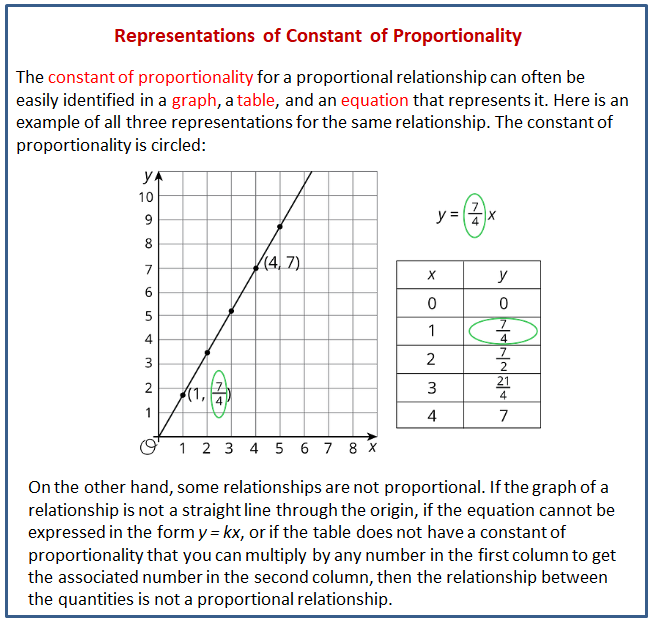Illustrative Mathematics Grade 7, Unit 2, Lesson 14: Representations of Constant of Proportionality
Learning Targets:
- I can make connections between the graphs, tables, and equations of a proportional relationship.
- I can use units to help me understand information about proportional relationships.
Related Pages
Illustrative Math
Grade 7
Lesson 14: Representations of Constant of Proportionality
Let’s contrast relationships that are and are not proportional in four different ways.
Illustrative Math Unit 7.2, Lesson 14 (printable worksheets)
Lesson 14 Summary
The following diagram shows how to represent a proportional relationship using the graphs, tables, and equations.

Lesson 14.1 Which is the Bluest?
- Which group of blocks is the bluest?
- Order the groups of blocks from least blue to bluest.
Lesson 14.2 One Scenario, Four Representations
- Select two things from different lists. Make up a situation where there is a proportional relationship between quantities that involve these things.
- Select two other things from the lists, and make up a situation where there is a relationship between quantities that involve these things, but the relationship is not proportional.
- Your teacher will give you two copies of the “One Scenario, Four Representations” sheet. For each of your situations, describe the relationships in detail. If you get stuck, consider asking your teacher for a copy of the sample response.
a. Write one or more sentences describing the relationship between the things you chose.
b. Make a table with titles in each column and at least 6 pairs of numbers relating the two things.
c. Graph the situation and label the axes.
d. Write an equation showing the relationship and explain in your own words what each number and letter in your equation means.
e. Explain how you know whether each relationship is proportional or not proportional. Give as many reasons as you can.
Lesson 14.3 Make a Poster
Create a visual display of your two situations that includes all the information from the previous activity.
Lesson 14 Practice Problems
- The equation c = 2.95g shows how much it costs to buy gas at a gas station on a certain day. In the equation, c represents the cost in dollars, and g represents how many gallons of gas were purchased.
a. Write down at least four (gallons of gas, cost) pairs that fit this relationship.
b. Create a graph of the relationship.
c. What does 2.95 represent in this situation?
d. Jada’s mom remarks, “You can get about a third of a gallon of gas for a dollar.” Is she correct? How did she come up with that? - There is a proportional relationship between a volume measured in cups and the same volume measured in tablespoons. 3 cups is equivalent to 48 tablespoons, as shown in the graph.
a. Plot and label at least two more points that represent the relationship.
b. Use a straightedge to draw a line that represents this proportional relationship.
c. For which value y is (1,y) on the line you just drew?
d. What is the constant of proportionality for this relationship?
e. Write an equation representing this relationship. Use for cups and for tablespoons.
The Open Up Resources math curriculum is free to download from the Open Up Resources website and is also available from Illustrative Mathematics.
Try out our new and fun Fraction Concoction Game.
Add and subtract fractions to make exciting fraction concoctions following a recipe. There are four levels of difficulty: Easy, medium, hard and insane. Practice the basics of fraction addition and subtraction or challenge yourself with the insane level.

We welcome your feedback, comments and questions about this site or page. Please submit your feedback or enquiries via our Feedback page.